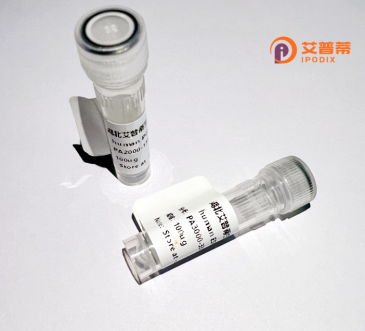
| 纯度 | >90%SDS-PAGE. |
| 种属 | Human |
| 靶点 | THAP8 |
| Uniprot No | Q8NA92 |
| 内毒素 | < 0.01EU/μg |
| 表达宿主 | E.coli |
| 表达区间 | 1-274 aa |
| 活性数据 | MPKYCRAPNC SNTAGRLGAD NRPVSFYKFP LKDGPRLQAW LQHMGCEHWV PSCHQHLCSE HFTPSCFQWR WGVRYLRPDA VPSIFSRGPP AKSQRRTRST QKPVSPPPPL QKNTPLPQSP AIPVSGPVRL VVLGPTSGSP KTVATMLLTP LAPAPTPERS QPEVPAQQAQ TGLGPVLGAL QRRVRRLQRC QERHQAQLQA LERLAQQLHG ESLLARARRG LQRLTTAQTL GPEESQTFTI ICGGPDIAMV LAQDPAPATV DAKPELLDTR IPSA |
| 分子量 | 30.0 kDa |
| 蛋白标签 | His tag N-Terminus |
| 缓冲液 | PBS, pH7.4, containing 0.01% SKL, 1mM DTT, 5% Trehalose and Proclin300. |
| 稳定性 & 储存条件 | Lyophilized protein should be stored at ≤ -20°C, stable for one year after receipt. Reconstituted protein solution can be stored at 2-8°C for 2-7 days. Aliquots of reconstituted samples are stable at ≤ -20°C for 3 months. |
| 复溶 | Always centrifuge tubes before opening.Do not mix by vortex or pipetting. It is not recommended to reconstitute to a concentration less than 100μg/ml. Dissolve the lyophilized protein in distilled water. Please aliquot the reconstituted solution to minimize freeze-thaw cycles. |
以下是假设性的参考文献示例,供参考(实际文献需通过学术数据库查询确认):
1. **"Cloning and Functional Analysis of Recombinant Human THAP8 Protein"**
- *作者:Zhang L, et al.*
- 摘要:报道了人源THAP8蛋白的重组表达及纯化方法,证实其通过THAP结构域结合特定DNA序列,可能参与细胞周期调控。
2. **"THAP8 Inhibits Hepatocellular Carcinoma Progression via Epigenetic Regulation"**
- *作者:Chen X, Wang Y.*
- 摘要:发现重组THAP8在肝癌细胞中抑制增殖和转移,可能与组蛋白修饰酶相互作用并调节靶基因表达。
3. **"Structural Characterization of Recombinant THAP8-Zinc Finger Complex"**
- *作者:Kim S, et al.*
- 摘要:通过晶体结构解析揭示THAP8蛋白的锌指结构域构象,为开发相关疾病治疗策略提供依据。
4. **"THAP8 as a Novel Regulator of Autophagy in Neurodegenerative Models"**
- *作者:Li R, et al.*
- 摘要:证明重组THAP8蛋白通过调控自噬相关通路减缓神经元损伤,提示其潜在神经保护作用。
**提示**:上述内容为简化示例,真实文献请通过PubMed或Web of Science检索关键词(如“THAP8 recombinant protein”)获取。
**Background of Recombinant Human THAP8 Protein**
THAP8 (THAP domain-containing protein 8) is a member of the THAP family of proteins, characterized by a conserved N-terminal THAP domain, a zinc finger-like motif that binds DNA and regulates transcription. Human THAP8 is encoded by the *THAP8* gene located on chromosome 19 and is implicated in diverse cellular processes, including transcriptional regulation, cell cycle control, and apoptosis. Though less studied than other THAP proteins (e.g., THAP1 or THAP9), emerging evidence suggests THAP8 may function as a transcriptional repressor or co-regulator, potentially interacting with chromatin-modifying complexes.
Recombinant human THAP8 protein is produced using expression systems (e.g., *E. coli* or mammalian cells) for *in vitro* studies. Its purification enables functional analyses, such as DNA-binding assays, protein interaction mapping, and enzymatic activity studies. Researchers utilize recombinant THAP8 to explore its role in diseases, particularly cancers, where dysregulation of THAP proteins has been linked to tumorigenesis. Additionally, structural studies of recombinant THAP8 aim to elucidate its DNA-binding specificity and interaction with partner proteins.
Despite progress, THAP8’s exact physiological targets and mechanisms remain poorly understood, highlighting the need for further research into its biological significance and therapeutic potential.
×